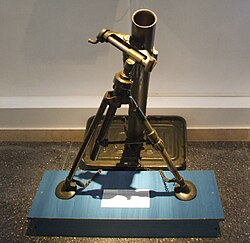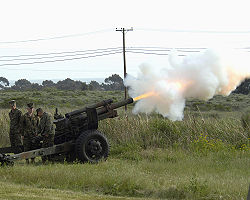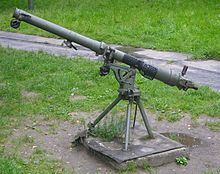The Laotian Civil War was a military conflict of the Cold War in Asia that pitted the guerrilla forces of the Marxist-oriented Pathet Lao against the armed and security forces of the Kingdom of Laos (French: Royaume du Laos), led by the conservative Royal Lao Government, between 1960 and 1975. Main combatants comprised:
Contents
- Royal Lao Armed Forces, FAN and SGUs equipment
- Revolvers
- Pistols
- Submachine guns
- Bolt-action rifles
- Carbines
- Sniper rifles
- Battle rifles
- Shotguns
- Light machine guns
- General-purpose machine guns
- Medium and heavy machine guns
- Grenade systems
- Land mine systems
- Rocket systems
- Anti-tank rockets
- Grenade launchers
- Recoilless rifles
- Mortars
- Howitzers
- Air defense guns
- Vehicles
- Helicopters
- Aircraft
- River craft
- Pathet Lao LPLA equipment
- Pistols 2
- Submachine guns 2
- Carbines 2
- Bolt-action rifles 2
- Sniper rifles 2
- Battle rifles 2
- Light machine guns 2
- General-purpose machine guns 2
- Medium and heavy machine guns 2
- Grenade systems 2
- Land mine systems 2
- Rocket systems 2
- Anti-tank rocket launchers
- Grenade launchers 2
- Recoilless rifles 2
- Mortars 2
- Howitzers 2
- Air defense guns 2
- Vehicles 2
- Helicopters 2
- Aircraft 2
- River craft 2
- See also
- Notes
- References
- External links
- The Royal Lao Armed Forces (French: Forces Armées du Royaume), best known by its French acronym FAR, were the official Military of the Kingdom of Laos from 1959 to 1975. Subordinated to the Ministry of Defense of the Royal Lao Government at the capital Vientiane, the FAR branches were organized as follows:
- Royal Lao Army (French: Armée Royale du Laos – ARL)
- Royal Lao Air Force (French: Aviation Royale Laotiènne – AVRL)
- Royal Lao Navy (French: Marine Royale Laotiènne – MRL)
- Paramilitary security forces:
- Royal Lao Police (French: Police Royale Laotiènne – PRL)
- Directorate of National Coordination (DNC) Security Agency; a.k.a. Border Police (French: Police de Frontiers), active from 1960 to 1965.
To meet the threat represented by the Pathet Lao insurgency, the Laotian Armed Forces depended on a small French military training mission (French: Mission Militaire Française près du Gouvernment Royale du Laos or MMF-GRL), [1] headed by a general officer, an exceptional arrangement permitted under the 1955 Geneva Accords, [2] as well as covert assistance from the United States [3] in the form of the Programs Evaluation Office (PEO), established on 15 December 1955, [4] replaced in 1961 by the Military Assistance Advisory Group (Laos), [5] which was later changed in September 1962 into the Requirements Office. [6] [7] Between 1962 and 1971, the U.S. provided Laos with direct military assistance, but not including the cost of equipping and training irregular and paramilitary forces by the Central Intelligence Agency (CIA). [8] In addition to U.S. covert support, the FAR received further military assistance from the United Kingdom, Thailand, Burma, the Philippines, the Republic of China (Taiwan), Cambodia, South Vietnam, South Korea, Japan, Indonesia, Singapore, Malaysia and Australia.
- The Neutralist Armed Forces (French: Forces Armées Neutralistes – FAN), a dissident splinter faction of the FAR led by Captain (later, Major general) Kong Le, active from 1961 to 1966, which received support from North Vietnam, the Soviet Union, Indonesia and the United States. [9] [10] [11] [12]
- The irregular Anti-communist Special Guerrilla Units (SGU), also collectively referred to as the "Clandestine Army" or "Secret Army" (French: Armée Clandestine or Armée Secréte), recruited from Laos' ethnic minorities such as the Hmong (Meo), Yao (Iu-Mien), Mien, Lao Theung (Hune) and Lao Sung hill tribes, was led by Royal Lao Government Minister Touby Lyfoung, Major general Vang Pao and Brigadier general Thao Ty. Created from irregular ethnic guerrilla units or "partisans" (French: Maquisards) raised earlier by the French GCMA Laos during the First Indochina War, the SGUs were in reality secretly organized, trained and armed by the CIA since the late 1950s and early 1960s. [13]


- The Pathet Lao, also known as the "Lao People's Party" (1955–1972) and later the "Lao People's Revolutionary Party" (1972–present) led by Prince Souphanouvong, and its military wing the Lao People's Liberation Army (LPLA), which was trained and armed by North Vietnam, the Soviet Union, the People's Republic of China, North Korea, Indonesia, Albania, East Germany, Romania and Cuba. [14]

- The People's Army of Vietnam (PAVN), also designated the "North Vietnamese Army" (NVA), which received support from the Soviet Union, the People's Republic of China, North Korea, East Germany, Czechoslovakia, Poland, Hungary, Bulgaria and Yugoslavia.
- The Army of the Republic of Vietnam (ARVN), which received support from the United States, Australia, Canada, France, West Germany, Israel, Japan, New Zealand, Philippines, South Korea, Pahlavi Iran, Francoist Spain, Taiwan, Thailand and the United Kingdom.
An eclectic variety of weapons was used by all sides in the Laotian Civil War. Laotian regular FAR and FAN and irregular SGUs weaponry in the early days of the War was a hodgepodge, with most of their combat units equipped in a haphazard way with an array of French, American, Australian, British and German weapon systems, mostly of WWII-vintage, either drawn from First Indochina War stocks handed down by the French or secretly provided by the Americans. [15] [16] After 1955 however, the FAR began the process of standardisation on U.S. equipment, with its airborne and infantry units first taking delivery of semi-automatic and automatic small-arms of WWII/Korean War-vintage in late 1959, followed by the delivery between 1963 and 1971 of more modern military equipments, which included aircraft, armored and transport vehicles, and long-range artillery pieces. In 1969 secret deliveries of modern U.S. small-arms arrived in Laos, and were initially only given to the Laotian Royal Guard and airborne units; standardisation in U.S. fully-automatic infantry weapons in the RLA and the irregular SGUs was completed by 1971, replacing much of the older weaponry. [17] [18] Captured infantry weapons of Soviet and Chinese origin were also employed by elite commando or airborne units and the irregular SGUs while on special operations in the enemy-held areas of north-eastern and south-eastern Laos. [19] [20]
During the early phase of the War, the Pathet Lao likewise was largely equipped with WWII-vintage French, Japanese, American, British, German, Chinese and Czechoslovakian weapons either pilfered from French colonial forces during the First Indochina War, seized from Laotian FAR units or provided by the Vietminh and subsequently by North Vietnam. As the war progressed, these obsolete weapons began to be partially superseded by more modern Eastern Bloc military hardware, including semi-automatic and fully automatic small-arms, artillery pieces, armored and transport vehicles, and aircraft of Soviet, Chinese and Hungarian origin, mostly being funnelled through the North Vietnamese. Although the Pathet Lao standardized on Soviet and Chinese weapons and equipment by the early 1970s, its guerrilla forces continued to make use of captured enemy stocks until the end of the War.






























